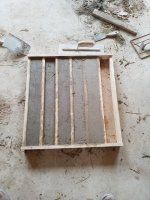Woods
Active Member
watched the entire thing but where did he mention this? Or why do you wonder about 5 days between coats being an issue? In my experience, once most of the moisture is out of the plaster, which can be 1 to 3 days on masonry and a little longer on strawbales or lath, the plaster won't shrink anymore. After the initial drying the carbonation phase starts. But in my experience, this doesn't affect shrinkage.5 days between lime coats could be an issue on jobs here ?
Shrinkage isn't even a problem if you got your mix spot on. If you have to much clay or lime in your plaster, shrinkage may cause some cracking to occur. So if you skim the wall before it's completely dry, the shrinkage cracks in the base coat will also crack the skim coat.
But if your mix is on point, you can pretty much skim when the plaster feels solid enough.
In fact, there is a technique where you skim coat with pure lime putty (usually with pigments added) when the base coat is firm but still wet. You skim the wall with an ultra thin coat of buttery smooth lime putty. You essentially skim it "into" the base coat. Timing is very important with this technique, but it works. It saves a lot on material costs because you barely use any lime and you can get a mirror finish in this way. I would also assume this would give a very strong bond since both the base coat and skim coat will carbonate at the same time.
But you can also skim a wall after it is dry and even when it has fully cured. The difference is just that you can't use pure lime because if you skim pure lime at 3mm thickness, you'll get cracks all over. So you need a fine aggregate like marmer dust, chalk, very fine sand added to the lime.


